Doped Nanoscale NMC333 as Cathode Materials for Li-Ion Batteries
Abstract
1. Introduction
2. Materials and Methods
3. Results and Discussion
3.1. Structural Analysis
3.2. Morphology
3.3. Local Structure
3.4. Electrochemical Properties
4. Discussion
5. Conclusions
Author Contributions
Funding
Acknowledgments
Conflicts of Interest
References
- Julien, C.M.; Mauger, A.; Vijh, A.; Zaghib, K. Lithium Batteries: Science and Technology; Springer: Cham, Switzerland, 2016. [Google Scholar]
- Goodenough, J.B. Energy storage materials: A perspective. Energy Storage Mater. 2015, 1, 158–161. [Google Scholar] [CrossRef]
- Konarov, A.; Myung, S.-T.; Sun, Y.-K. Cathode materials for future electric vehicles and energy storage systems. Acs Energy Lett. 2017, 2, 703–708. [Google Scholar] [CrossRef]
- Mizushima, K.; Jones, P.C.; Wiseman, P.J.; Goodenough, J.B. LixCoO2 (0 < x < −1): A new cathode material for batteries of high energy density. Mater. Res. Bull. 1980, 15, 783–789. [Google Scholar]
- Daniel, C.; Mohanty, D.; Li, J.; Wood, D.L. Cathode materials review. AIP Conf. Proc. 2014, 1597, 26. [Google Scholar]
- Senyshyn, A.; Mühlbauer, M.J.; Nikolowski, K.; Pirling, T.; Ehrenberg, H. In-operando neutron scattering studies on Li-ion batteries. J. Power Sources 2012, 203, 126–129. [Google Scholar] [CrossRef]
- Laubach, S.; Laubach, S.; Schmidt, P.C.; Ensling, D.; Schmid, S.; Jaegermann, W.; Thißen, A.; Nikolowski, K.; Ehrenberg, H. Changes in the crystal and electronic structure of LiCoO2 and LiNiO2 upon Li intercalation and de-intercalation. Phys. Chem. Chem. Phys. 2009, 11, 3278–3289. [Google Scholar] [CrossRef]
- Ohzuku, T.; Makimura, Y. Layered lithium insertion material of Li1/2Mn1/2O2: A possible alternative to LiCoO2 for advanced lithium-ion batteries. Chem. Lett. 2001, 30, 744–745. [Google Scholar] [CrossRef]
- Zhecheva, E.; Stoyanova, R. Stabilization of the layered crystal structure of LiNiO2 by Co-substitution. Solid State Ion. 1993, 66, 143–149. [Google Scholar] [CrossRef]
- Julien, C.; El-Farh, L.; Rangan, S.; Massot, M. Studies of LiNi1−yCoyO2 cathode materials prepared by a citric acid-assisted sol-gel method for lithium batteries. J. Sol-Gel Sci. Technol. 1999, 15, 63–72. [Google Scholar] [CrossRef]
- Chen, Y.; Wang, G.X.; Konstantinov, K.; Liu, H.K.; Dou, S.X. Synthesis and characterization of LiCoxMnyNi1−x−yO2 as a cathode material for secondary lithium batteries. J. Power Sources 2003, 119–121, 184–188. [Google Scholar] [CrossRef]
- Ben-Kamel, K.; Amdouni, N.; Abdel-Ghany, A.; Zaghib, K.; Mauger, A.; Gendron, F.; Julien, C.M. Local structure and electrochemistry of LiNiyMnyCo1−2yO2 electrode materials for Li-ion batteries. Ionics 2008, 14, 89–97. [Google Scholar] [CrossRef]
- Luo, G.; Zhao, J.; Ke, X.; Zhang, P.; Sun, H.; Wang, B. Structure, electrode voltage and activation energy of LiMnxCoyNi1−x−yO2 solid solutions as cathode materials for Li batteries from first-principles. J. Electrochem. Soc. 2012, 159, A1203–A1208. [Google Scholar] [CrossRef]
- MacNeil, D.D.; Lu, Z.; Dahn, J.R. Structure and electrochemistry of Li[NixCo1−2xMnx]O2 (0 ≤ x ≤ ½). J. Electrochem. Soc. 2002, 149, A1332–A1336. [Google Scholar] [CrossRef]
- Noh, H.-J.; Youn, S.; Yoon, C.S.; Sun, Y.-K. Comparison of the structural and electrochemical properties of layered Li[NixCoyMnz]O2 (x = 1/3, 0.5, 0.6, 0.7, 0.8 and 0.85) cathode material for lithium-ion batteries. J. Power Sources 2013, 233, 121–130. [Google Scholar] [CrossRef]
- Jouanneau, S.; Eberman, K.W.; Krause, L.J.; Dahn, J.R. Synthesis, characterization, and electrochemical behavior of improved Li[NixCo1−2xMnx]O2 (0.1 ⩽ x ⩽ 0.5). J. Electrochem. Soc. 2003, 150, A1637–A1642. [Google Scholar] [CrossRef]
- Zhang, X.; Jiang, W.J.; Mauger, A.; Gendron, F.; Julien, C.M.; Qilu, R. Minimization of the cation mixing in Li1+x(NMC)1−xCo1/3O2 as cathode material. J. Power Sources 2010, 195, 1292–1301. [Google Scholar] [CrossRef]
- Ohzuku, T.; Makimura, Y. Layered lithium insertion material of LiNi1/3Co1/3Mn1/3O2 for lithium-ion batteries. Chem. Lett. 2001, 30, 642–643. [Google Scholar] [CrossRef]
- Shaju, K.M.; Subba-Rao, G.V.; Chowdari, B.V.R. Performance of layered Li(Ni1/3Co1/3Mn1/3)O2 as cathode for Li-ion batteries. Electrochim. Acta 2002, 48, 145–151. [Google Scholar] [CrossRef]
- Hashem, A.M.A.; Abdel-Ghany, A.E.; Eid, A.E.; Trottier, J.; Zaghib, K.; Mauger, A.; Julien, C.M. Study of the surface modification of LiNi1/3Co1/3Mn1/3O2 cathode material for lithium ion battery. J. Power Sources 2011, 196, 8632–8637. [Google Scholar] [CrossRef]
- Kang, K.; Ceder, G. Factors that affect Li mobility in layered lithium transition metal oxides. Phys. Rev. B 2006, 74, 094105. [Google Scholar] [CrossRef]
- Fergus, J.W. Recent developments in cathode materials for lithium ion batteries. J. Power Sources 2010, 195, 939–954. [Google Scholar] [CrossRef]
- Eiler-Rethwish, M.; Winter, M.; Schappacher, F.M. Synthesis, electrochemical investigation and structural analysis of doped Li[Ni0.6Mn0.2Co0.2-xMx]O2 (x = 0, 0.05; M = Al, Fe, Sn) cathode materials. J. Power Sources 2018, 387, 101–107. [Google Scholar] [CrossRef]
- Cho, W.; Song, J.H.; Lee, K.-W.; Lee, M.-W.; Kim, H.; Yu, J.-S.; Kim, Y.-J.; Kim, K.J. Improved particle hardness of Ti-doped LiNi1/3Co1/3Mn1/3−xTixO2 as high voltage cathode material for lithium-ion batteries. J. Phys. Chem. Solids 2018, 123, 271–278. [Google Scholar] [CrossRef]
- Li, G.Y.; Huang, Z.L.; Zuo, Z.C.; Zhang, Z.J.; Zhou, H.H. Understanding the trace Ti surface doping on promoting the low temperature performance of LiNi1/3Co1/3Mn1/3O2 cathode. J. Power Sources 2015, 281, 69–76. [Google Scholar] [CrossRef]
- Chen, Q.Y.; Du, C.Q.; Zhang, X.; Tang, Z. Syntheses and characterization of Zr-doped LiNi0.4Co0.2Mn0.4O2 cathode materials for lithium ion batteries. RSC Adv. 2015, 5, 75248–75253. [Google Scholar] [CrossRef]
- Wu, J.; Liu, H.; Ye, X.; Xia, J.; Lu, Y.; Lin, C.; Yu, X. Effect of Nb doping on electrochemical properties of LiNi1/3Co1/3Mn1/3O2 at high cutoff voltage for lithium-ion battery. J. Alloy. Compd. 2015, 644, 223–227. [Google Scholar] [CrossRef]
- Wilcox, J.D.; Patoux, S.; Doeff, M.M. Structure and electrochemistry of LiNi1/3Co1/3−yMyMn1/3O2 (M = Ti, Al, Fe) positive electrode materials. J. Electrochem. Soc. 2009, 156, A192–A198. [Google Scholar] [CrossRef]
- Liu, L.; Sun, K.; Zhang, N.; Yang, T. Improvement of high-voltage cycling behavior of Li(Ni1/3Co1/3Mn1/3)O2 cathodes by Mg, Cr, and Al substitution. J. Solid State Electrochem. 2009, 13, 1381–1386. [Google Scholar] [CrossRef]
- Yang, L.; Ren, F.; Feng, Q.; Xu, G.; Li, X.; Li, Y.; Zhao, E.; Ma, J.; Fan, S. Effect of Cu doping on the structural and electrochemical performance of LiNi1/3Co1/3Mn1/3O2 cathode materials. J. Electron. Mater. 2018, 47, 3996–4002. [Google Scholar] [CrossRef]
- Ding, Y.H.; Ping, Z.; Yong, J. Synthesis and electrochemical properties of Li[Ni1/3Co1/3Mn1/3]1−xLaxO2 cathode materials. J. Rare Earths 2007, 25, 268–270. [Google Scholar]
- Ding, Y.; Zhang, P.; Jiang, Y.; Gao, D. Effect of rare earth elements doping on structure and electrochemical properties of LiNi1/3Co1/3Mn1/3O2 for lithium-ion battery. Solid State Ion. 2007, 178, 967–971. [Google Scholar] [CrossRef]
- Zhang, Y.; Xia, S.; Zhang, Y.; Dong, P.; Yan, X.; Yang, R. Ce-doped LiNi1/3Co(1/3−x/3)Mn1/3Cex/3O2 cathode materials for use in lithium ion batteries. Chin. Sci. Bull. 2012, 57, 4181–4187. [Google Scholar] [CrossRef][Green Version]
- Wang, M.; Chen, Y.; Wu, F.; Su, Y.; Chen, L.; Wang, D. Characterization of yttrium substituted LiNi0.33Mn0.33Co0.33O2 cathode material for lithium secondary cells. Electrochim. Acta 2010, 55, 8815–8820. [Google Scholar] [CrossRef]
- Du, H.; Zheng, Y.; Dou, Z.; Zhan, H. Zn-doped LiNi1/3Co1/3Mn1/3O2 composite as cathode material for lithium ion battery: Preparation, characterization, and electrochemical properties. J. Nanomater. 2015, 16, 339. [Google Scholar] [CrossRef]
- Liu, D.; Wang, Z.; Chen, L. Comparison of structure and electrochemistry of Al- and Fe-doped LiNi1/3Co1/3Mn1/3O2. Electrochim. Acta 2006, 51, 4199–4203. [Google Scholar] [CrossRef]
- Wu, F.; Wang, M.; Su, Y.; Bao, L.; Chen, S. A novel layered material of LiNi0.32Mn0.33Co0.33Al0.01O2 for advanced lithium-ion batteries. J. Power Sources 2010, 195, 2900–2904. [Google Scholar] [CrossRef]
- Ren, H.; Li, X.; Peng, Z. Electrochemical properties of Li[Ni1/3Mn1/3Al1/3−xCox]O2 as a cathode material for lithium ion battery. Electrochim. Acta 2011, 56, 7088–7091. [Google Scholar] [CrossRef]
- Milewska, A.; Molenda, M.; Molenda, J. Structural, transport and electrochemical properties of LiNi1−yCoyMn0.1O2 and Al, Mg and Cu-substituted LiNi0.65Co0.25Mn0.1O2 oxides. Solid State Ion. 2011, 192, 313–320. [Google Scholar] [CrossRef]
- Meng, Y.S.; Wu, Y.W.; Hwang, B.J.; Li, Y.; Ceder, G. Combining ab initio computation with experiments for designing new electrode materials for advanced lithium batteries: LiNi1/3Fe1/6Co1/6Mn1/3O2. J. Electrochem. Soc. 2004, 151, A1134–A1140. [Google Scholar] [CrossRef]
- Liu, Q.; Du, K.; Guo, H.; Peng, Z.-D.; Cao, Y.-B.; Hu, G.-R. Structural and electrochemical properties of Co-Mn-Mg multi-doped nickel based cathode materials LiNi0.9Co0.1−x[Mn1/2Mg1/2]xO2 for secondary lithium ion batteries. Electrochim. Acta 2013, 90, 350–357. [Google Scholar] [CrossRef]
- Lv, C.; Yang, J.; Peng, Y.; Duan, X.; Ma, J.; Li, Q.; Wang, T. 1D Nb-doped LiNi1/3Co1/3Mn1/3O2 nanostructures as excellent cathodes for Li-ion battery. Electrochim. Acta 2019, 297, 258–266. [Google Scholar] [CrossRef]
- Lin, Y.-K.; Lu, C.-H. Preparation and electrochemical properties of layer structured LiNi1/3Co1/3Mn1/3−yAlyO2. J. Power Sources 2009, 189, 353–358. [Google Scholar] [CrossRef]
- Zhou, F.; Zhao, X.; Dahn, J.R. Synthesis, electrochemical properties, and thermal stability of Al-doped LiNi1/3Mn1/3−yCo(1/3−z)AlzO2 positive electrode materials. J. Electrochem. Soc. 2009, 156, A343–A347. [Google Scholar] [CrossRef]
- Zhou, F.; Zhao, X.; Jiang, J.; Dahn, J.R. Advantages of simultaneous substitution of Co in Li[Ni1/3Mn1/3Co1/3]O2 by Ni and Al. Electrochem. Solid-State Lett. 2009, 12, A81–A83. [Google Scholar] [CrossRef]
- Hashem, A.M.; Abdel-Ghany, A.E.; Abuzeid, H.M.; El-Tawil, R.S.; Indris, S.; Ehrenberg, H.; Mauger, A.; Julien, C.M. EDTA as chelating agent for sol-gel synthesis of spinel LiMn2O4 cathode material for lithium batteries. J. Alloy. Compd. 2018, 737, 758–766. [Google Scholar] [CrossRef]
- Hashem, A.M.; El-Taweel, R.S.; Abuzeid, H.M.; Abdel-Ghany, A.E.; Eid, A.E.; Groult, H.; Mauger, A.; Julien, C.M. Structural and electrochemical properties of LiNi1/3Co1/3Mn1/3O2 material prepared by a two-step synthesis via oxalate precursor. Ionics 2012, 18, 1–9. [Google Scholar] [CrossRef]
- El-Mofid, W.; Ivanov, S.; Konkin, A.; Bund, A. A high-performance layered transition metal oxide cathode material obtained by simultaneous aluminum and iron cationic substitution. J. Power Sources 2014, 268, 122–141. [Google Scholar] [CrossRef]
- Ohzuku, T.; Ueda, A.; Nagayama, M. Electrochemistry and structural chemistry of LiNiO2 (R3̅m) for 4 volt secondary lithium cells. J. Electrochem. Soc. 1993, 140, 1862–1870. [Google Scholar] [CrossRef]
- Dahn, J.R.; von Sacken, U.; Michal, C.A. Structure and electrochemistry of Li1±yNiO2 and a new Li2NiO2 phase with the Ni(OH)2 structure. Solid State Ion. 1990, 44, 87–97. [Google Scholar] [CrossRef]
- Reimers, J.N.; Rossen, E.; Jones, C.D.; Dahn, J.R. Structure and electrochemistry of LixFeyNi1−yO2. Solid State Ion. 1993, 61, 335–344. [Google Scholar] [CrossRef]
- Chang, C.-C.; Kim, J.Y.; Kumta, P.N. Divalent cation incorporated Li(1+x)MMgxO2(1+x) (M = Ni0.75Co0.25): Viable cathode materials for rechargeable lithium-ion batteries. J. Power Sources 2000, 89, 56–63. [Google Scholar] [CrossRef]
- Kim, G.-H.; Myung, S.-T.; Kim, H.-S.; Sun, Y.-K. Synthesis of spherical Li[Ni(1/3−z)Co(1/3−z)Mn(1/3−z)Mgz]O2 as positive electrode material for lithium-ion battery. Electrochim. Acta 2006, 51, 2447–2453. [Google Scholar] [CrossRef]
- Shannon, R. Revised effective ionic radii and systematic studies of interatomic distances in halides and chacogenides. Acta Cryst. A 1976, 32, 751–767. [Google Scholar] [CrossRef]
- Tran, N.; Croguennec, L.; Jordy, C.; Biensan, P.; Delmas, C. Influence of the synthesis route on the electrochemical properties of LiNi0.425Mn0.425Co0.15O2. Solid State Ion. 2005, 176, 1539–1547. [Google Scholar] [CrossRef]
- Zhang, X.; Mauger, A.; Lu, Q.; Groult, H.; Perrigaud, L.; Gendron, F.; Julien, C.M. Synthesis and characterization of LiNi1/3Mn1/3Co1/3O2 by wet chemical method. Electrochim. Acta 2010, 55, 6440–6449. [Google Scholar] [CrossRef]
- Grey, C.P.; Dupre, N. NMR studies of cathode materials for lithium-ion rechargeable batteries. Chem. Rev. 2004, 104, 4493–4512. [Google Scholar] [CrossRef] [PubMed]
- Cahill, L.S.; Yin, S.C.; Samoson, A.; Heinmaa, I.; Nazar, L.F.; Goward, G.R. 6Li NMR studies of cation disorder and transition metal ordering in Li[Ni1/3Mn1/3Co1/3]O2 using ultrafast magic angle spinning. Chem. Mater. 2005, 17, 6560–6566. [Google Scholar] [CrossRef]
- Han, B.; Key, B.; Lapidus, S.H.; Garcia, J.C.; Iddir, H.; Vaughey, J.T.; Dogan, F. From coating to dopant: How the transition metal composition affects alumina coatings on Ni-rich cathodes. Acs Appl. Mater. Interfaces 2017, 9, 41291–41302. [Google Scholar] [CrossRef]
- Ye, S.; Xia, Y.; Zhang, P.; Qiao, Z. Al, B, and F doped LiNi1/3Co1/3Mn1/3O2 as cathode material of lithium-ion batteries. J. Solid State Electrochem. 2007, 11, 805–810. [Google Scholar] [CrossRef]
- Riley, L.A.; Van Atta, S.; Cavanagh, A.S.; Yan, Y.; George, S.M.; Liu, P.; Dillon, A.C.; Lee, S.-H. Electrochemical effects of ALD surface modification on combustion synthesized LiNi1/3Mn1/3Co1/3O2 as a layered-cathode material. J. Power Sources 2011, 196, 3317–3324. [Google Scholar] [CrossRef]
- Yabuuchi, N.; Makimura, Y.; Ohzuku, T. Solid-state chemistry and electrochemistry of LiCo1 ∕ 3Ni1 ∕ 3Mn1 ∕ 3O2 for advanced lithium-ion batteries: III. Rechargeable capacity and cycleability. J. Electrochem. Soc. 2007, 154, A314–A321. [Google Scholar] [CrossRef]
- Li, Z.-Y.; Zhang, H.-L. The improvement for the electrochemical performances of LiNi1/3Mn1/3Co1/3O2 cathode materials for lithium-ion batteries by both the Al-doping and an advanced synthetic method. Int. J. Electrochem. Sci. 2019, 14, 3524–3534. [Google Scholar] [CrossRef]
- Kobayashi, T.; Kawasaki, N.; Kobayashi, Y.; Shono, K.; Mita, Y.; Miyashiro, H. A method of separating the capacities of layer and spinel compounds in blended cathode. J. Power Sources 2014, 245, 1–6. [Google Scholar] [CrossRef]
- Luo, W.; Zhou, F.; Zhao, X.; Lu, Z.; Li, X.; Dahn, J.R. Synthesis, Characterization, and Thermal Stability of LiNi1/3Mn1/3Co1/3−zMgzO2, LiNi1/3−zMn1/3Co1/3MgzO2, and LiNi1/3Mn1/3−zCo1/3MgzO2. Chem. Mater. 2010, 22, 1164–1172. [Google Scholar] [CrossRef]
- Zhang, Q.; Zheng, Y.; Zhong, S. Preparation and electrochemical performance of Mg-doped LiNi0.4Co0.2Mn0.4O2 cathode materials by urea co-precipitation. Key Eng. Mater. 2012, 519, 152–155. [Google Scholar] [CrossRef]
- Chang, C.C.; Kim, J.Y.; Kumta, P.N. Synthesis and electrochemical characterization of divalent cation-incorporated lithium nickel oxide. J. Electrochem. Soc. 2000, 147, 1722–1729. [Google Scholar] [CrossRef]
- D’Epifanio, A.; Croce, F.; Ronci, F.; Rossi-Albertini, V.; Traversa, E.; Scrosati, B. Effect of Mg2+ doping on the structural, thermal, and electrochemical properties of LiNi0.8Co0.16Mg0.04O2. Chem. Mater. 2004, 16, 3559–3564. [Google Scholar] [CrossRef]
- Martha, S.K.; Hadar Sclar, K.; Framowitz, Z.S.; Kovacheva, D.; Saliyski, N.; Gofer, Y.; Sharona, P.; Golikc, E.; Markovskya, B.; Aurbach, D. A comparative study of electrodes comprising nanometric and submicron particles of LiNi0.50Mn0.50O2, LiNi0.33Mn0.33Co0.33O2, and LiNi0.40Mn0.40Co0.20O2 layered compounds. J. Power Sources 2009, 189, 248–255. [Google Scholar] [CrossRef]
- Ceder, G.; Chiang, Y.M.; Sadoway, D.R.; Aydinol, M.K.; Jang, Y.I.; Huang, B. Identification of cathode materials for lithium batteries guided by first-principles calculations. Nature 1998, 392, 694–696. [Google Scholar] [CrossRef]
- Castro-Couceiro, A.; Castro-Garcia, S.; Senaris-Rodriguez, M.A.; Soulette, F.; Julien, C. Influence of aluminium doping on the properties LiCoO2 and LiNi0.5Co0.5O2 oxides. Solid State Ion. 2003, 156, 15–26. [Google Scholar] [CrossRef]
- Samarasingha, P.B.; Wijayasinghe, A.; Behm, M.; Dissanayake, L.; Lindbergh, G. Development of cathode materials for lithium ion rechargeable batteries based on the system Li(Ni1/3Mn1/3Co(1/3−x)Mx)O2, (M = Mg, Fe, Al and x = 0.00 to 0.33). Solid State Ion. 2014, 268, 226–230. [Google Scholar] [CrossRef]
- Wang, M.; Chen, Y.; Wu, F.; Su, Y.F.; Chen, L. Improvement of the electrochemical performance of LiNi0.33Mn0.33Co0.33O2 cathode material by chromium doping. Sci. China Technol. Sci. 2010, 53, 3214–3220. [Google Scholar] [CrossRef]
- Prado, G.; Fournès, L.; Delmas, C. On the LixNi0.70Fe0.15Co0.15O2 system: An X-ray diffraction and Mössbauer study. J. Solid State Chem. 2001, 159, 103–112. [Google Scholar] [CrossRef]
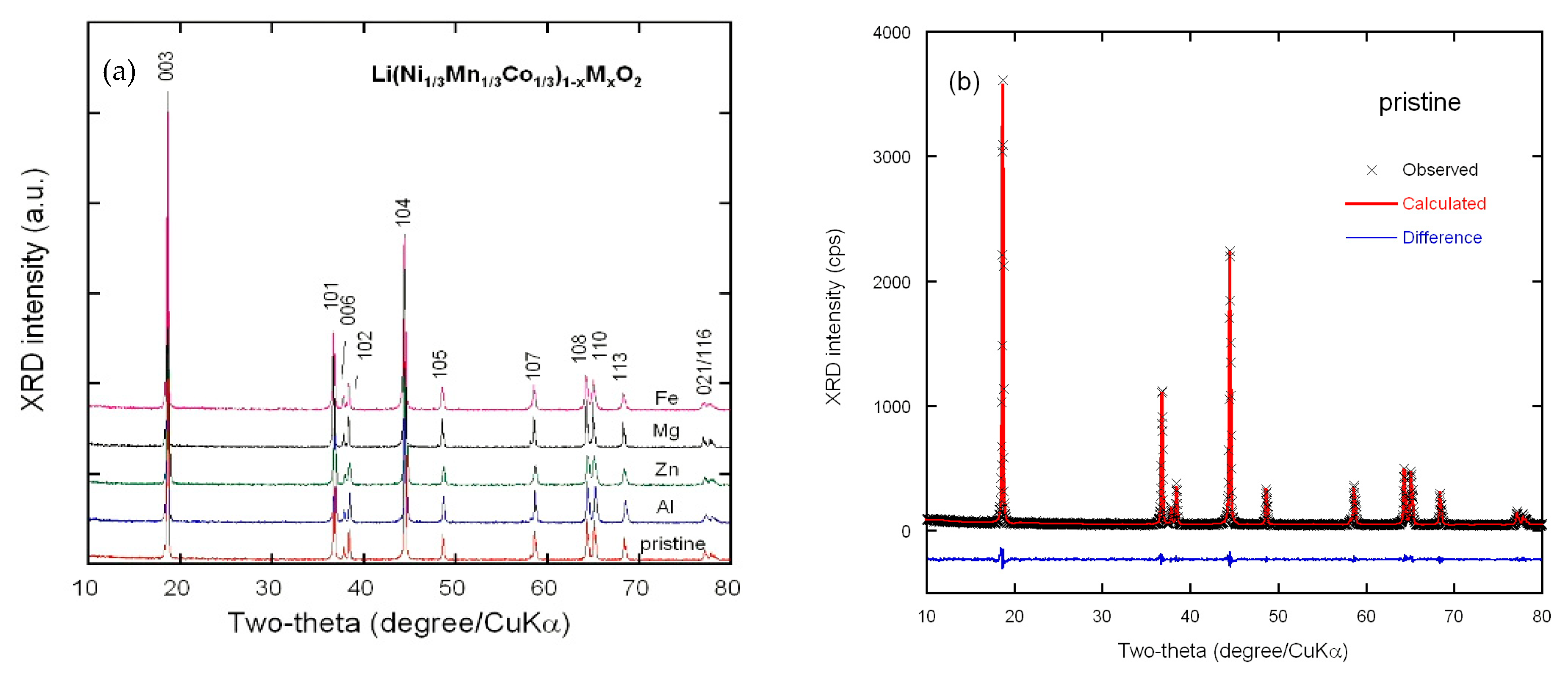

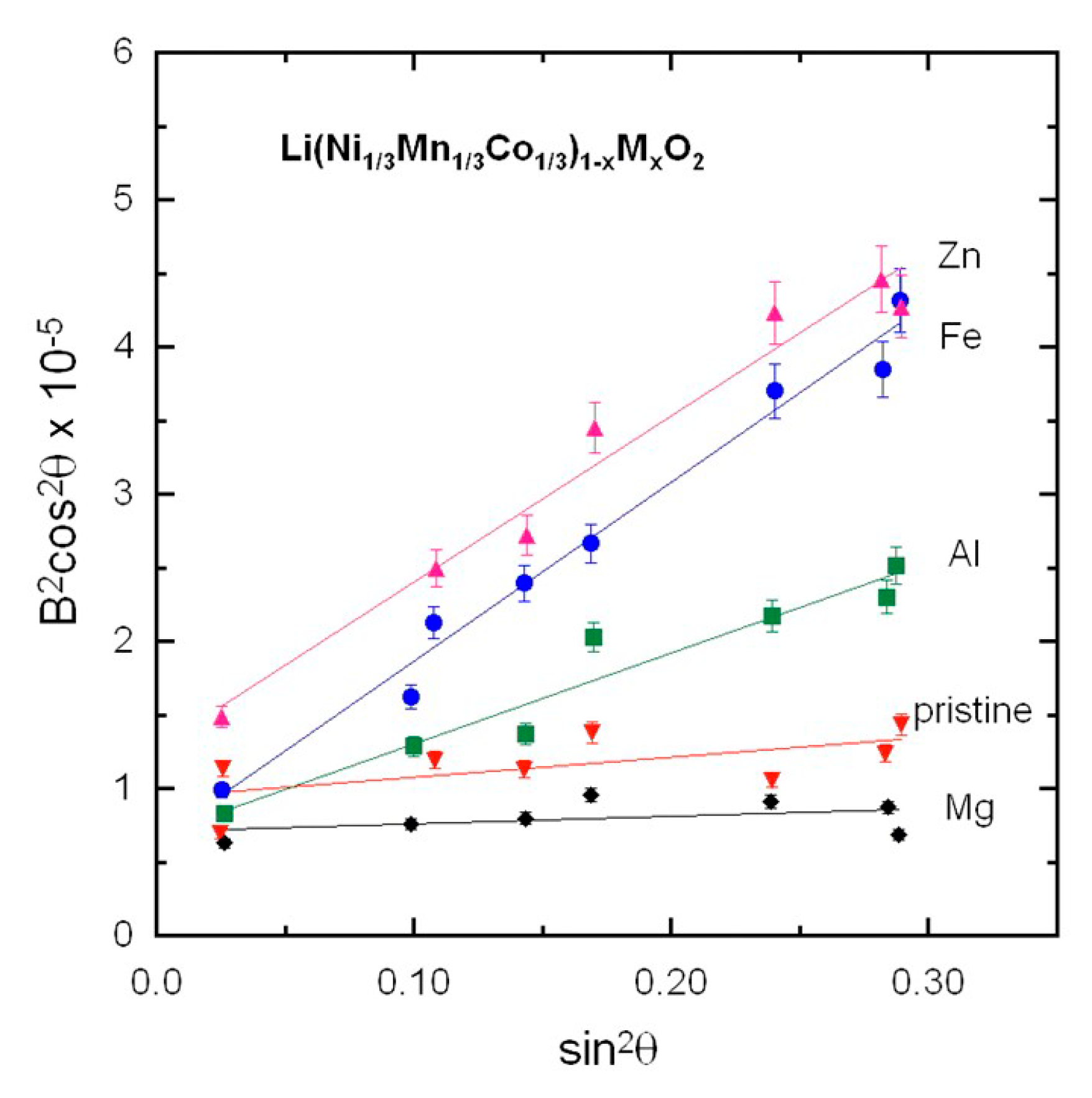


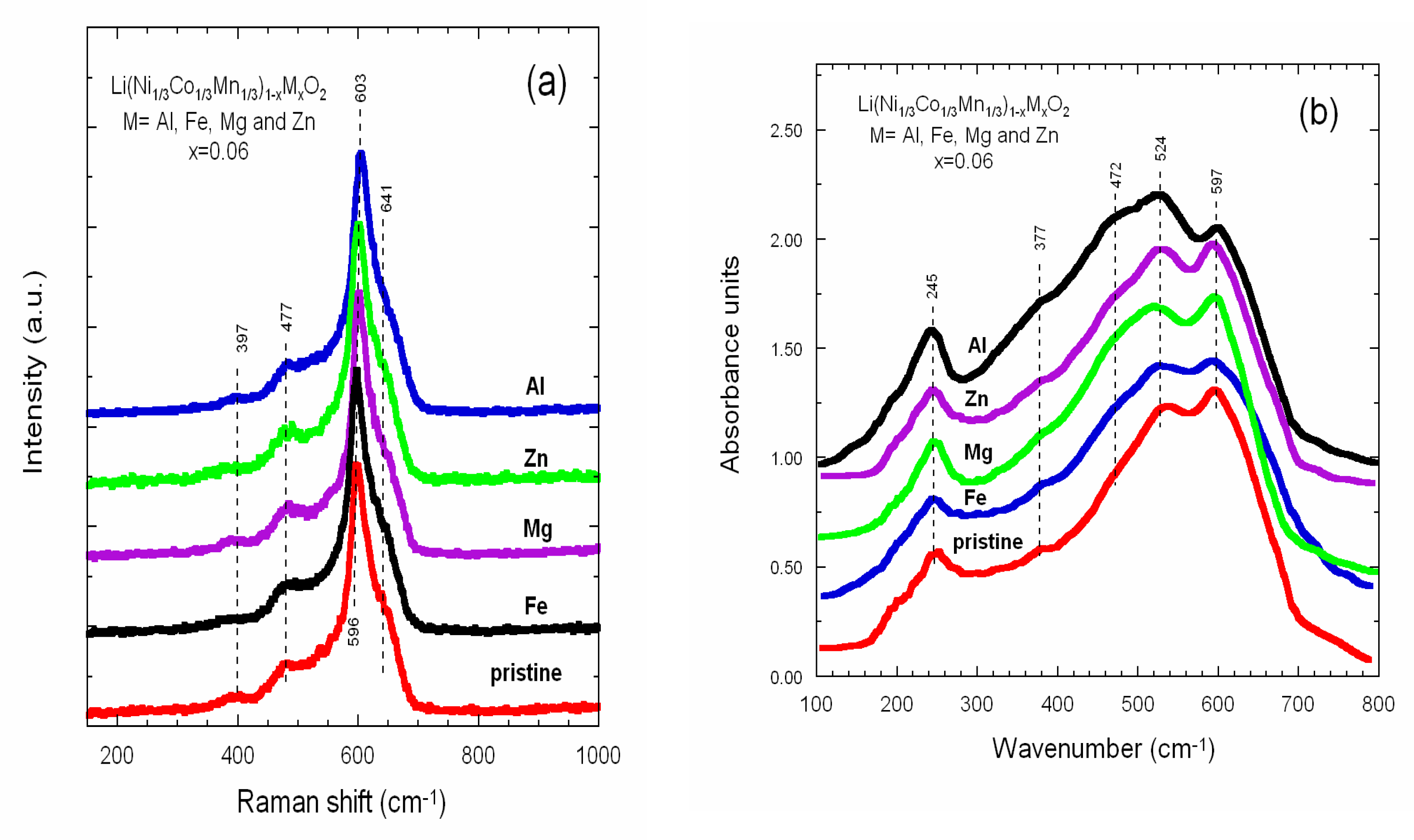
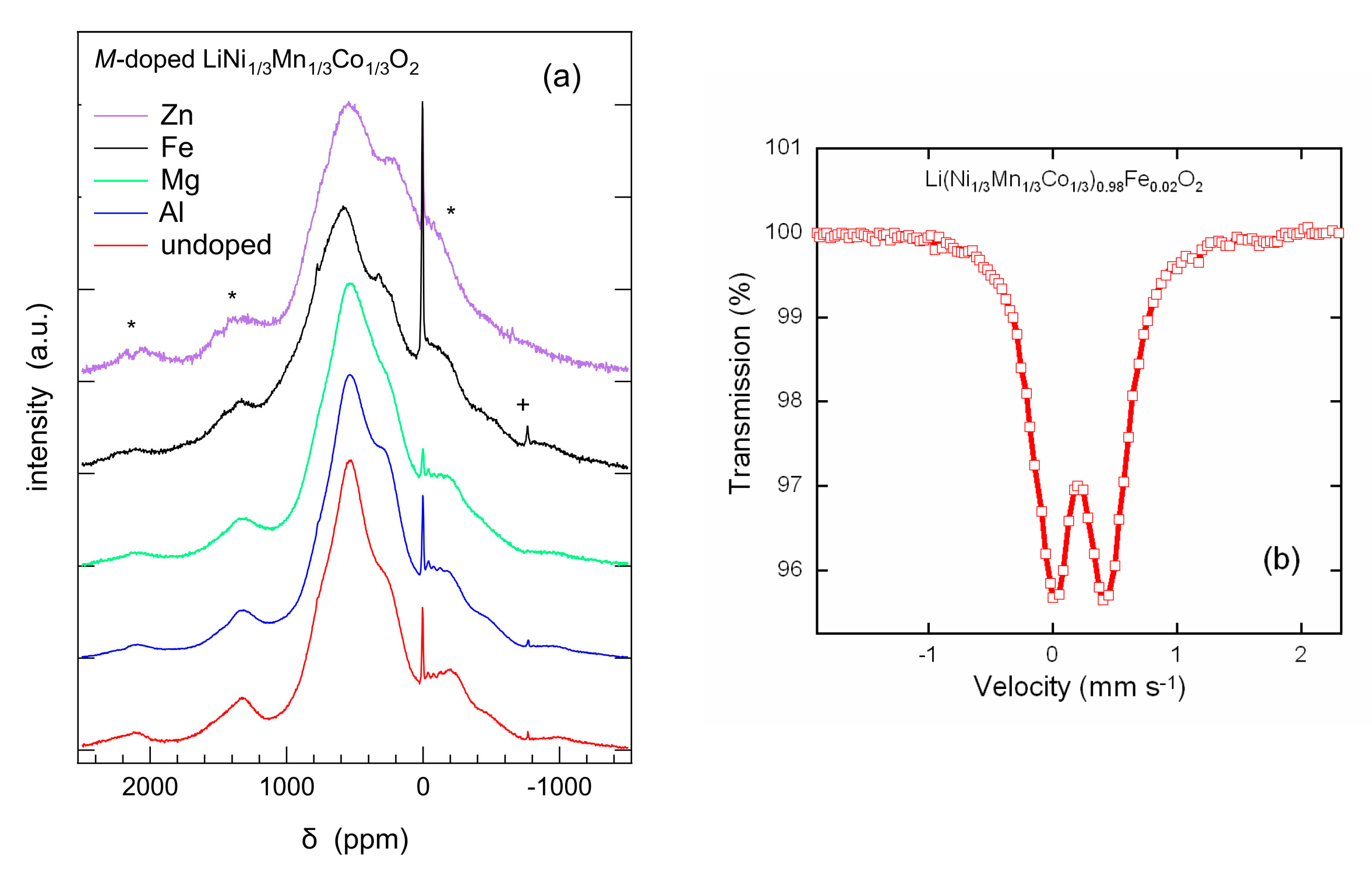

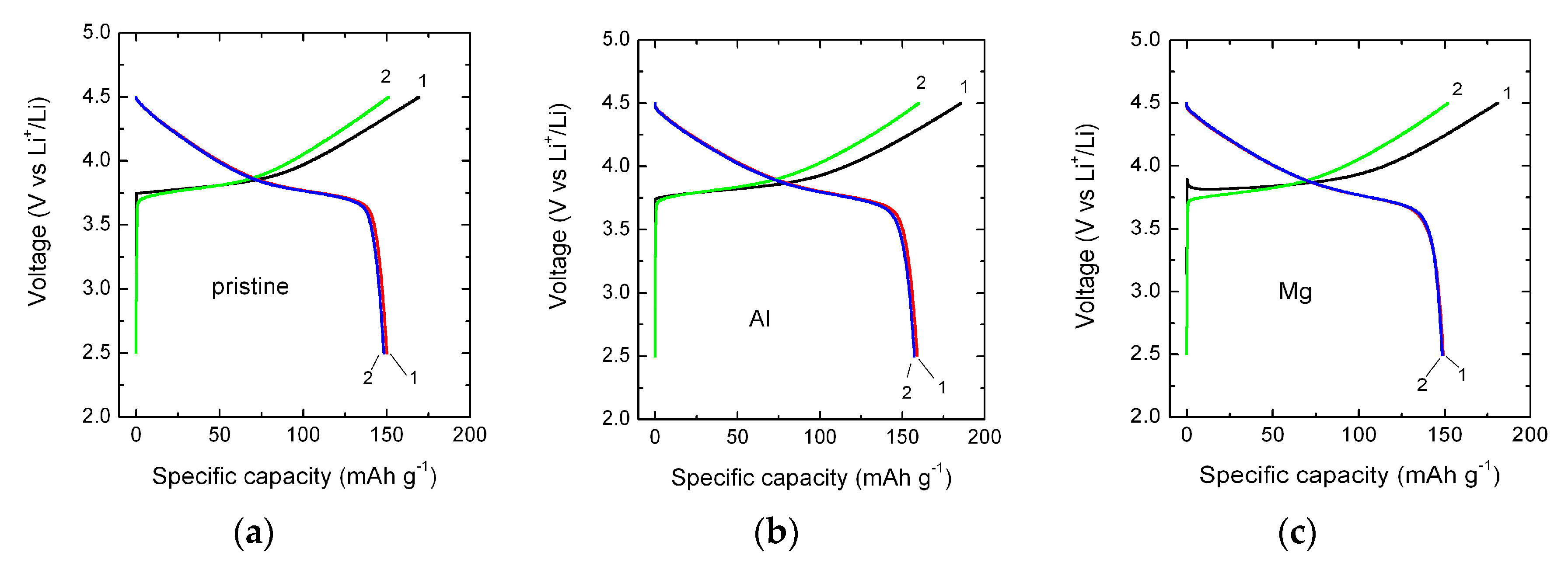
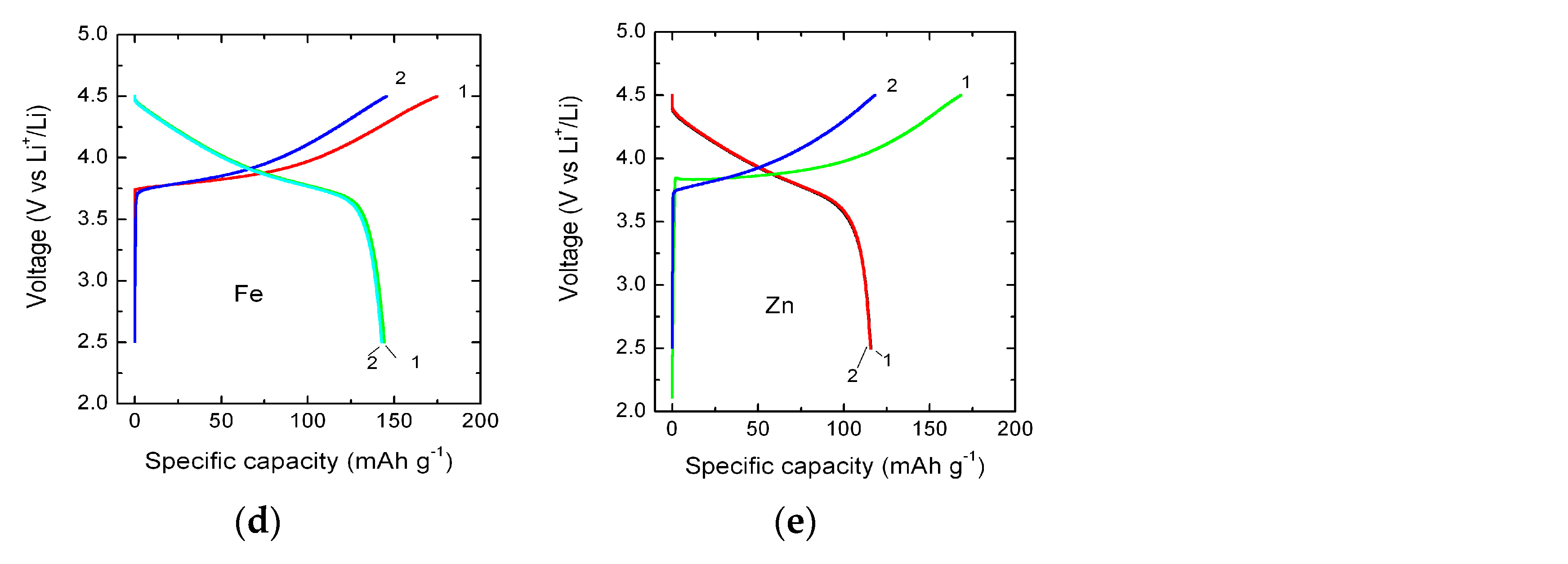
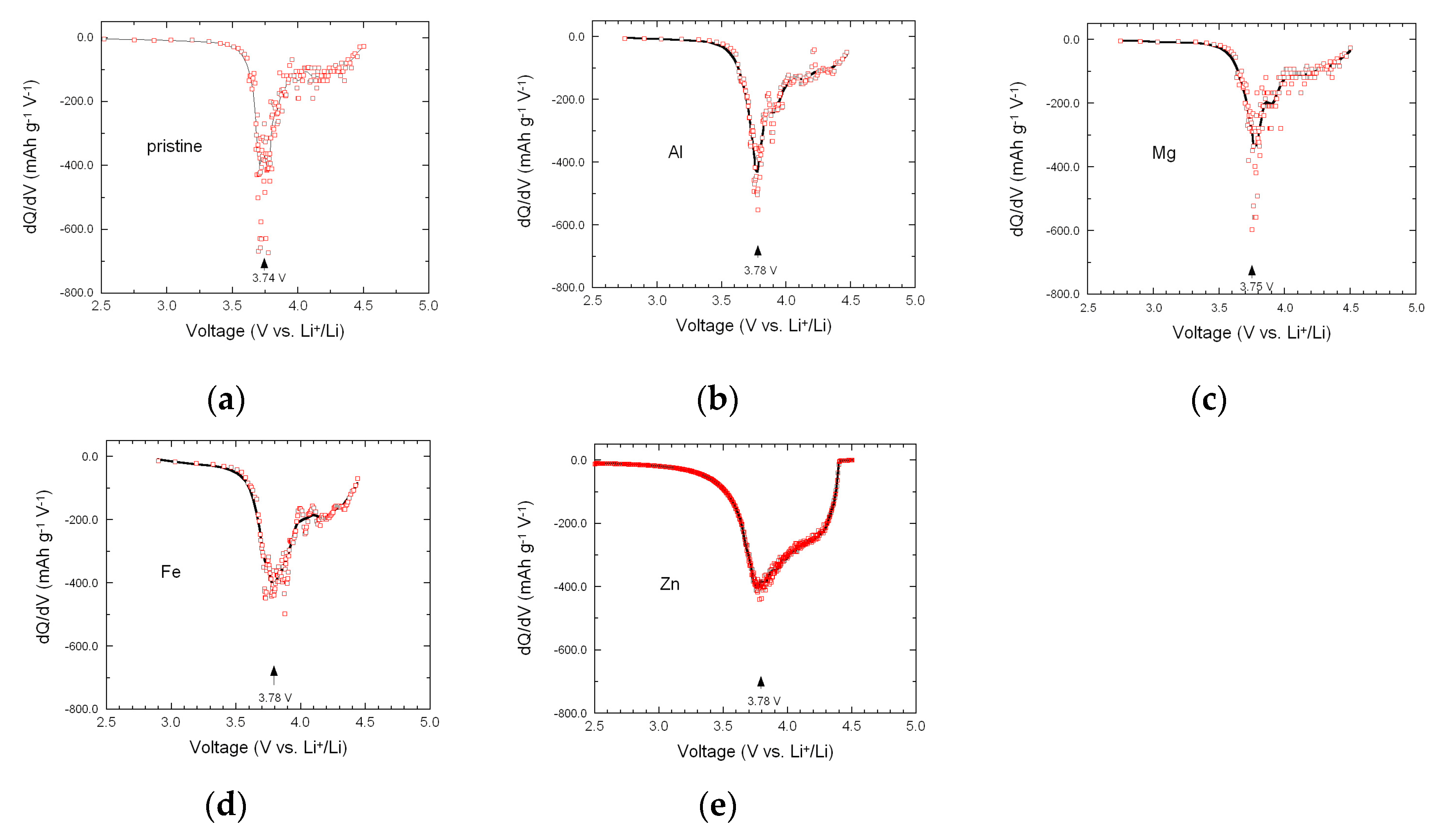

| Crystal Data | Parent | Doping Element (M) | |||
|---|---|---|---|---|---|
| Mg | Al | Fe | Zn | ||
| Lattice parameters | - | - | - | - | - |
| a (Å) | 2.856 (2) | 2.865 (4) | 2.858 (5) | 2.867 (1) | 2.864 (7) |
| c (Å) | 14.249 (5) | 14.259 (7) | 14.255 (9) | 14.276 (7) | 14.243 (1) |
| c/a | 4.980 (1) | 4.976 (3) | 4.987 (1) | 4.979 (4) | 4.964 (9) |
| V (Å3) | 100.65 | 101.39 | 100.88 | 101.62 | 101.22 |
| Lc (nm) | 18.7 | 17.3 | 25.6 | 14.8 | 15.8 |
| <e2> × 10−5 (rd2) | 0.2899 | 0.4221 | 0.1303 | 0.8743 | 0.8458 |
| I(003)/I(104) | 1.61 | 1.83 | 1.53 | 1.49 | 1.22 |
| (I(006) + I(102))/I(101) | 0.47 | 0.42 | 0.49 | 0.58 | 0.56 |
| Residuals | - | - | - | - | - |
| Rp(%) | 8.17 | 8.44 | 8.92 | 9.15 | 10.21 |
| Rwp(%) | 9.01 | 9.69 | 11.07 | 11.50 | 13.81 |
| RF | 1.68 | 2.16 | 3.16 | 5.31 | 4.12 |
| Occupancy (Occ) | - | - | - | - | - |
| Ni2+ on Li-site | 0.0241 | 0.0024 | 0.0142 | 0.0129 | 0.0113 |
| M on Li-site | - | 0.0127 | - | - | 0.0222 |
| (0,0,z) for O2 | 0.25921 | 0.2607 | 0.25964 | 0.2585 | 0.25230 |
| S(MO2)a (Å) | 2.1139 | 2.0714 | 2.1011 | 2.1367 | 2.2882 |
| I(LiO2)b (Å) | 2.6393 | 2.6817 | 2.6508 | 2.6222 | 2.4595 |
| Dopant | Shift (ppm) | Irel | Shift (ppm) | Irel | Shift (ppm) | Irel | %Li/Ni Exchange |
|---|---|---|---|---|---|---|---|
| None | 274.9 | 21.1 | 541.4 | 66.9 | 747.3 | 12.0 | 3.11 |
| Al | 277.1 | 26.2 | 539.8 | 62.0 | 731.0 | 11.7 | 1.65 |
| Mg | 289.0 | 28.5 | 533.4 | 52.1 | 716.6 | 19.4 | 3.03 |
| Fe | 283.5 | 7.0 | 563.4 | 54.9 | 776.1 | 38.1 | 2.08 |
| Zn | 217.9 | 28.8 | 541.0 | 49.7 | 743.0 | 21.5 | 2.74 |
| Potential (V Versus Li+/Li) | Doping Element | ||||
|---|---|---|---|---|---|
| Pristine | Al | Mg | Fe | Zn | |
| Epa | 3.83 | 3.86 | 3.83 | 3.86 | 3.85 |
| Epc | 3.72 | 3.75 | 3.73 | 3.76 | 3.72 |
| ΔEp | 0.11 | 0.11 | 0.10 | 0.10 | 0.13 |
© 2019 by the authors. Licensee MDPI, Basel, Switzerland. This article is an open access article distributed under the terms and conditions of the Creative Commons Attribution (CC BY) license (http://creativecommons.org/licenses/by/4.0/).
Share and Cite
Hashem, A.M.; Abdel-Ghany, A.E.; Scheuermann, M.; Indris, S.; Ehrenberg, H.; Mauger, A.; Julien, C.M. Doped Nanoscale NMC333 as Cathode Materials for Li-Ion Batteries. Materials 2019, 12, 2899. https://doi.org/10.3390/ma12182899
Hashem AM, Abdel-Ghany AE, Scheuermann M, Indris S, Ehrenberg H, Mauger A, Julien CM. Doped Nanoscale NMC333 as Cathode Materials for Li-Ion Batteries. Materials. 2019; 12(18):2899. https://doi.org/10.3390/ma12182899
Chicago/Turabian StyleHashem, Ahmed M., Ashraf E. Abdel-Ghany, Marco Scheuermann, Sylvio Indris, Helmut Ehrenberg, Alain Mauger, and Christian M. Julien. 2019. "Doped Nanoscale NMC333 as Cathode Materials for Li-Ion Batteries" Materials 12, no. 18: 2899. https://doi.org/10.3390/ma12182899
APA StyleHashem, A. M., Abdel-Ghany, A. E., Scheuermann, M., Indris, S., Ehrenberg, H., Mauger, A., & Julien, C. M. (2019). Doped Nanoscale NMC333 as Cathode Materials for Li-Ion Batteries. Materials, 12(18), 2899. https://doi.org/10.3390/ma12182899







